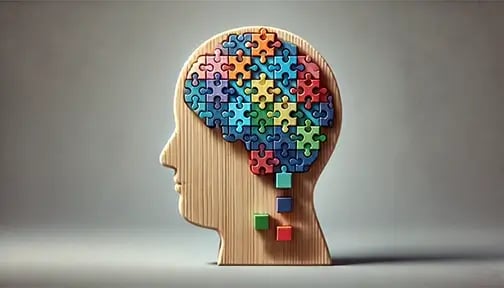Have you ever tried to memorize a long sequence of numbers or a dense paragraph of information, only to forget most of it moments later? You’re not alone. The human brain struggles to retain large amounts of information when it’s presented in a disorganized way. However, there’s a powerful learning strategy that can help: chunking.
This is a cognitive technique that involves breaking down complex information into smaller, manageable groups, making it easier to process, understand, and remember. This method is widely used in education, professional development, and everyday life to improve recall and comprehension.
In this blog post, we’ll explore what chunking is, why it works, and how you can use it to master difficult subjects. Whether you’re a student, teacher, home educator, or lifelong learner, this guide will help you transform overwhelming information into structured knowledge.
What Is Chunking?
This is the process of grouping related information together to improve memory retention. Instead of attempting to memorize a long list of random facts, chunking allows you to organize information into meaningful patterns or categories.
A simple example of this is how we remember phone numbers. Instead of recalling a 10-digit number as one long string (1234567890), we naturally divide it into smaller chunks (123-456-7890), making it easier to remember.
This technique applies to more than just numbers—it can be used for language learning, studying, note-taking, and even everyday problem-solving.
Why Does It Work?
This is effective because it aligns with how the brain processes information. Our working memory, which holds temporary information, has a limited capacity—typically about 4 to 7 items at a time. By grouping multiple pieces of data into a single "chunk," we reduce the cognitive load, making it easier for the brain to store and retrieve information.
1. Organizes Information into Meaningful Patterns
- The brain remembers patterns and relationships better than isolated facts.
- Instead of memorizing "H, O, M, E," we store it as a single meaningful word: "HOME."
2. Reduces Cognitive Overload
- Breaking complex topics into smaller sections prevents mental fatigue.
- It’s easier to study five key concepts than fifty individual details.
3. Increases Long-Term Retention
- Studies show that structured learning improves memory.
- Meaningful chunks become part of existing knowledge, making recall easier.
How to Use It for Better Learning
Step 1: Identify the Key Information
Before chunking, you need to identify the essential elements of what you're trying to learn.
- Highlight main ideas in a textbook or article.
- Identify recurring patterns, themes, or formulas.
- Summarize concepts in your own words before grouping them.
Step 2: Group Related Concepts Together
Once you’ve identified key points, organize them into logical clusters.
- For Numbers: Break long numbers into groups (e.g., credit card numbers).
- For Vocabulary: Categorize words by theme or context (e.g., food, animals, verbs).
- For History: Group events into time periods or key figures.
- For Science: Organize facts into cause-and-effect relationships.
Step 3: Use Mnemonics and Memory Tricks
Pair chunking with other memory techniques like:
- Acronyms: ROYGBIV (Colors of the rainbow: Red, Orange, Yellow, etc.)
- Rhymes: "Thirty days hath September…"
- Visualization: Associating a chunk with a mental image (e.g., picturing a story for history events).
Step 4: Reinforce with Repetition and Active Recall
Chunking is most effective when paired with spaced repetition and active recall.
- Review your chunks at increasing intervals.
- Test yourself by trying to recall the grouped information before checking notes.
- Use flashcards, quizzes, and practice questions to strengthen memory pathways.
Different Learning Scenarios
1. Studying for Exams
Students often feel overwhelmed with dense textbooks. Instead of reading passively, they can:
- Break chapters into sections with headings.
- Group related facts into lists, tables, or mind maps.
- Use color-coded notes to separate concepts.
2. Learning a New Language
Memorizing vocabulary is challenging without structure. This makes it easier by:
- Organizing words into categories (e.g., food, travel, emotions).
- Learning phrases instead of single words to improve fluency.
- Using word association to connect similar-sounding words.
3. Remembering Speeches or Presentations
Instead of memorizing an entire speech word-for-word, break it into sections:
- Introduction → Key Points → Supporting Examples → Conclusion
- Memorize each chunk separately, then connect them naturally.
- Use a storytelling approach to create a logical flow.
4. Retaining Complex Processes at Work
For professionals, learning new systems can be difficult. This system helps by:
- Organizing steps into phases or workflows.
- Creating checklists to remember important steps.
- Using flowcharts or diagrams to visualize processes.
Using Hole-Punched Index Cards for Chunking
One of the best tools for implementing chunking is hole-punched index cards. These cards allow you to create portable, customizable study systems that can be easily rearranged as needed.
How to Use Index Cards for Chunking:
- Write one key concept per card. Keep explanations brief.
- Group related cards together using binder rings. For example, group all biology terms or math formulas.
- Create a hierarchical system. Use dividers or colored cards to separate categories.
- Review cards based on difficulty. Move cards between stacks (easy, medium, hard) as you master them.
- Carry your index cards for quick review sessions throughout the day.
Using Debra Dale Designs Hole-Punched Index Cards makes it easy to stay organized and create a flexible learning system tailored to your needs.
Chunking + Other Learning Techniques = Maximum Retention
While chunking is powerful on its own, it works even better when combined with:
- Spaced Repetition – Reviewing chunks at increasing time intervals.
- Active Recall – Testing yourself on each chunk without looking at notes.
- Dual Coding – Using visuals + words (e.g., charts, diagrams, flashcards).
- Memory Palaces – Associating chunks with specific locations in your mind.
Final Thoughts: Unlocking Better Memory with Chunking
Chunking is a simple yet highly effective way to break down complex topics into manageable sections. By structuring information into logical groups, you reduce cognitive overload, improve recall, and make learning easier.
Whether you’re studying for exams, learning a new language, or organizing work tasks, this method can help you master information faster and more effectively.
For an easy-to-use tool that enhances chunking, try our Debra Dale Designs Hole-Punched Index Cards—a perfect way to organize and retain knowledge efficiently.




